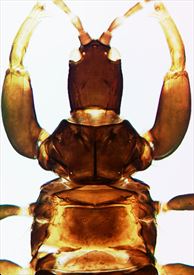Distinguishing features
Female fully winged or with wings variably short to micropterous. Body brown, antennal segment III yellow at extreme base; fore wings weakly shaded, darker at base. Head longer than tube; compound eyes as large dorsally as ventrally; postocular setae as long as distance between their bases; ocellar setae as long as distance between posterior ocelli, arising between or slightly behind them; maxillary stylets reaching more than halfway into head. Antennal segment III slightly longer than IV; segment III with 2 sense cones, IV with 4. Metanotum broad, with faint lines of sculpture laterally and a pair of setae medially. Fore tarsal tooth small. Fore wings variable in length, with 3 major sub-basal setae, S3 the longest; 5 duplicated cilia on fully developed wing. Pelta with broad lateral lobes, without small setae laterally on median lobe; tergites III–VI with curved wing-retaining setae; tergite IX posteromarginal setae about half as long as tube, with S1 and S2 subequal in length; anal setae nearly as long as tube.
Male micropterous, similar to but sometimes smaller than female; fore tarsal tooth large.
Related species
The genus Nesothrips includes 31 species, of which 6 are endemic to New Zealand, 13 are from Australia, 9 described from various Pacific islands, and 3 from southeast Asia. Nesothrips species usually have a rather short head, with a pair of setae between the hind ocelli, and the maxillary stylets wide apart. N. doulli is one of the species in this genus with the head slightly longer than wide. As in N. eastopi, the fore wings are remarkably variable in length, and the species does not exist as a discrete series of wing-morphs.
Biological data
Feeding on fungal spores on a dead walnut twig, and under Cytisus bark.
Distribution data
Known only from New Zealand (BP / SD, MC).
Family name
PHLAEOTHRIPIDAE, IDOLOTHRIPINAE
Species name
Nesothrips doulli (Mound)
Original name and synonyms
Rhaebothrips doulli Mound, 1974: 171
References
Mound LA & Palmer JM (1983) The generic and tribal classification of spore-feeding Thysanoptera (Phlaeothripidae: Idolothripinae). Bulletin of the British Museum (Natural History). Entomology 46: 1–174.
Mound LA & Walker AK (1986) Tubulifera (Insecta: Thysanoptera). Fauna of New Zealand 10: 1–140.

